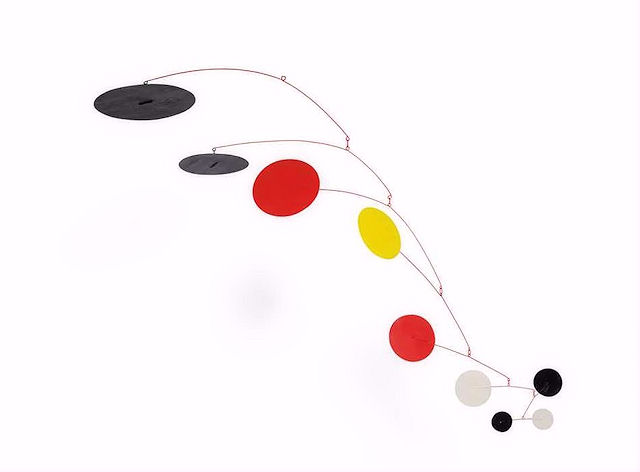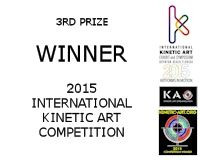Calder’s “Hello Allentown”, hanging mobile, for sale
[Update: Christie’s will have four Calder mobiles for sale on May 15th 2013]
Christie’s Post War and Contemporary Art Evening Auction on October 11th 2012 in London will include Alexander Calder‘s “Hello Allentown“, a hanging mobile he made the same year he passed away, 1976.
Expected to go for US$ 2 to 3 Million. More affordable options are here and here.

Before moving on to the Lot Notes, does anyone know if this quote is really by Calder: “The perpetually changing relations within the mobile gives them a metaphysical identity that relies on temporal memory to assemble the sequence of partial definitions comprising the more complex identity of the whole.”
Lot Notes: ‘The simplest forms in the universe are the sphere and the circle, I represent them by discs and then I vary them. My whole theory about art is the disparity that exists between form, masses and movement’ (A. Calder, quoted in K. Kuh, The Artist’s Voice: Talks with Seventeen Artists, New York, 1962).
Suspended from a sequence of bright red wires, the progression of multi-coloured discs that glides through the air is a triumphal example of Alexander Calder’s iconic mobile sculptures. Having once formed part of the historic collection of Philip and Muriel Berman and in fact titled after their hometown, Allentown, Pennsylvania, Hello Allentown is a tribute to the lifelong journey of collecting during which they amassed an impressive collection of monumental and important sculpture, paintings, drawings and prints. True civic leaders well known for their philanthropy as well as their commitment to championing the work of both young aspiring artists and the masters of their time, Philip and Muriel Berman collection was a testament to their personal connection with the art and in many instances their personal friendships with the artists, a friendship evident through the very title of Hello Allentown. With the artist signature aplomb, the vibrant spheres occupy both the vertical and horizontal planes, commanding the space in which they hang. The black discs that mark the highest and lowest point of Calder constellation act to contain the energetic eruptions of fiery reds and iridescent yellow that are contained within the centre of the configuration. Hello Allentown incorporates two of Calder favourite monikers – his exuberant use of colour and his formal examination of the spherical form. Through these two devices Calder investigates the formal relationship between two of the most basics tenets of art – form and colour – and how they interact, particularly in three-dimensional form. From the large black disc at the apex of the composition the eye is drawn down through a series of graceful arching limbs, each of which supports a round disc which decreases in size as the sculpture draws to a triumphal conclusion, ‘The simplest forms in the universe are the sphere and the circle Calder once said, ‘I represent them by discs and then I vary them. My whole theory about art is the disparity that exists between form, masses and movement’ (A. Calder, quoted in K. Kuh, The Artist’s Voice: Talks with Seventeen Artists, New York, 1962).
In addition to its elegantly balanced form, Hello Allentown is also distinguished by its chromatic range and intensity. Colour was an important expressive device for the artist and one of the most important factors in his compositions. For Calder, colour was not a representational force but rather an emotional one, in much the same way as Henri Matisse and André Derain, the historical pioneers in non-traditional use of colour. As Calder himself once commented: ”I want things to be differentiated. Black and white are first – then red is next. I often wish that I had been a Fauve in 1905” (A. Calder, quoted in Calder, London 2004, p. 89). Hello Allentown clearly demonstrates this philosophy with its harmonious use of black and white discs to compliment the chromatic brilliance of its red and yellow core.
Whilst Calder”s influential visit to Mondrian”s Parisian studio in 1930 is well documented as being the spark that ignited his interest in introducing colour and movement into sculpture, it is perhaps his friendship with Joan Miró that had the greatest influence on his career. The two men first met in 1928 and remained lifelong friends until Calder death in 1976. ”We became very good friends,” Calder once said, ”and attended may things together I came to love his painting, his colour, his personages” (A. Calder, quoted in E. Hutton and O. Wick (eds.), Calder, Miró, London 2004, p. 27). Their friendship was based on outsiders from the established art scene and reveled in their disdain of convention. From the early stages of their relationship, the pair explored the increasingly dominant field of abstraction – Calder prompted by his visit to Piet Mondrian”s atelier and Miró with his painterly forms that would eventually morph themselves into his iconic Constellations a few years later. The various coloured discs of Hello Allentown recall the lyrical, semi-abstracted forms of Miró paintings, a visual relationship that is emphasised by the fact that they held together by wires which resonate with the elegant sense of calligraphic line of the Spanish artist.
The present work is a rare example of a mobile that was produced during the latter part of Calder”s career. From the mid-1950s onwards Calder became increasingly concerned with making large-scale outdoor sculptures, making over three hundred monumental works that were placed in city plazas, corporate lobbies, airports and museum during the post-war building boom. It was through an incredible act of generosity and through their friendship with Calder that Philip and Muriel Berman, the renown first owners of Hello Allentown, provided the financing for Homage to Jerusalem-Stabile (1977), a work that would prove to be the last monumental sculpture planned by Calder but which he would not live to see installed on the site he chose on Jerusalem”s Holland Square. That Calder would return to his beloved mobiles during the final year of his life is testament to the importance in which he held this forms. As such, Hello Allentown represents the pinnacle of Calder”s approach to the prevailing march towards abstraction. Calder wanted to redefine the nature of art, and of sculpture in particular, by taking it off the wall and the pedestal and breathing movement into its static form. The resulting mobiles were his revolutionary response to these ideas of movement and colour and Hello Allentown is the superb result of Calder”s unfettered imagination and his unmatched technical skill as an engineer that enabled him to produce works that spring into life with the slightest breath of wind.

